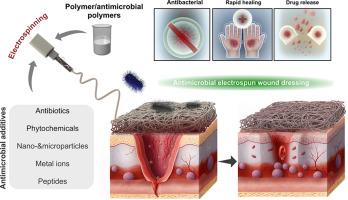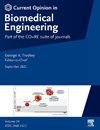用于伤口敷料的抗菌静电纺纳米纤维
IF 4.2
3区 工程技术
Q2 ENGINEERING, BIOMEDICAL
引用次数: 0
摘要
电纺纳米纤维具有高孔隙率、机械柔韧性、易于功能化和与细胞外基质结构相似的特点,是先进伤口敷料的通用平台。它们结合生物活性成分和细胞结合基序的能力促进了细胞粘附、增殖、抗菌防御和组织再生。本文综述了抗菌静电纺丝伤口敷料的最新进展(自2020年以来),重点介绍了由天然和合成聚合物及其混合物组成的系统。首先简要介绍了静电纺丝技术和静电纺丝敷料的优点。关键功能化策略使用抗生素,抗菌肽和植物化学物质,金属离子,无机纳米颗粒,然后在其对抗细菌感染的机制的背景下阐述。定制材料成分和实现可控释放的能力,以及嵌入再生线索的能力,使静电纺纳米纤维敷料成为治疗急性和慢性伤口的有力候选者。本文章由计算机程序翻译,如有差异,请以英文原文为准。

Antibacterial electrospun nanofibers for wound dressing applications
Electrospun nanofibers, with their high porosity, mechanical flexibility, ease of functionalization, and structural similarity to the extracellular matrix, represent a versatile platform for advanced wound dressings. Their capacity to incorporate bioactive components and cell-binding motifs facilitates cellular adhesion, proliferation, antimicrobial defense, and tissue regeneration. This review highlights recent progress (since 2020) in the development of antibacterial electrospun wound dressings, emphasizing systems composed of natural and synthetic polymers, as well as their hybrids. The electrospinning technique and the advantages of electrospun wound dressings are first briefly discussed. Key functionalization strategies using antibiotics, antibacterial peptides and phytochemicals, metal ions, and inorganic nanoparticles are then elaborated in the context of their mechanisms for combating bacterial infections. The ability to tailor material composition and achieve controlled release, along with embedding regenerative cues, makes electrospun nanofiber dressings strong candidates for treating both acute and chronic wounds.
求助全文
通过发布文献求助,成功后即可免费获取论文全文。
去求助
来源期刊

Current Opinion in Biomedical Engineering
Medicine-Medicine (miscellaneous)
CiteScore
8.60
自引率
2.60%
发文量
59
 求助内容:
求助内容: 应助结果提醒方式:
应助结果提醒方式:


